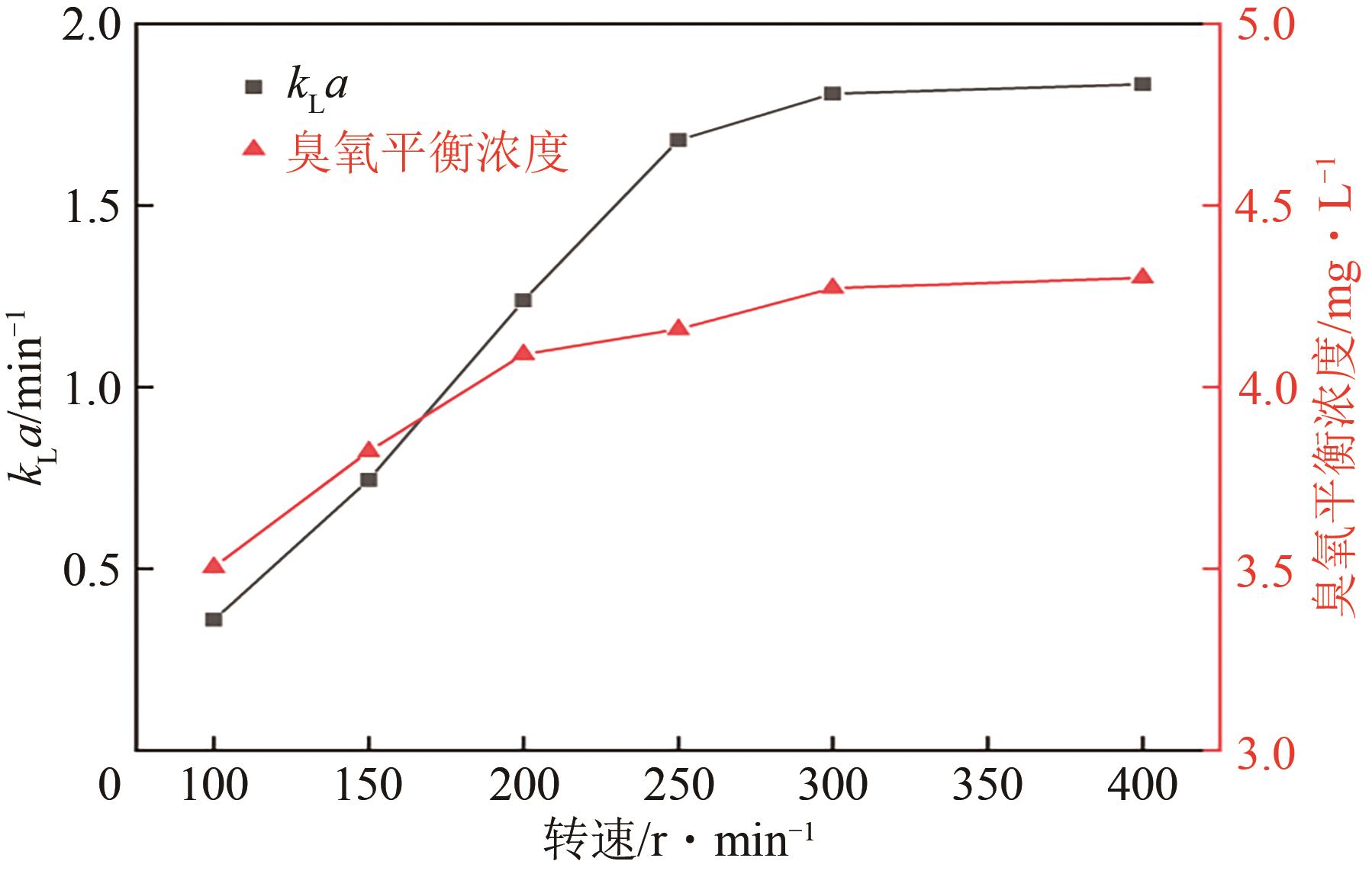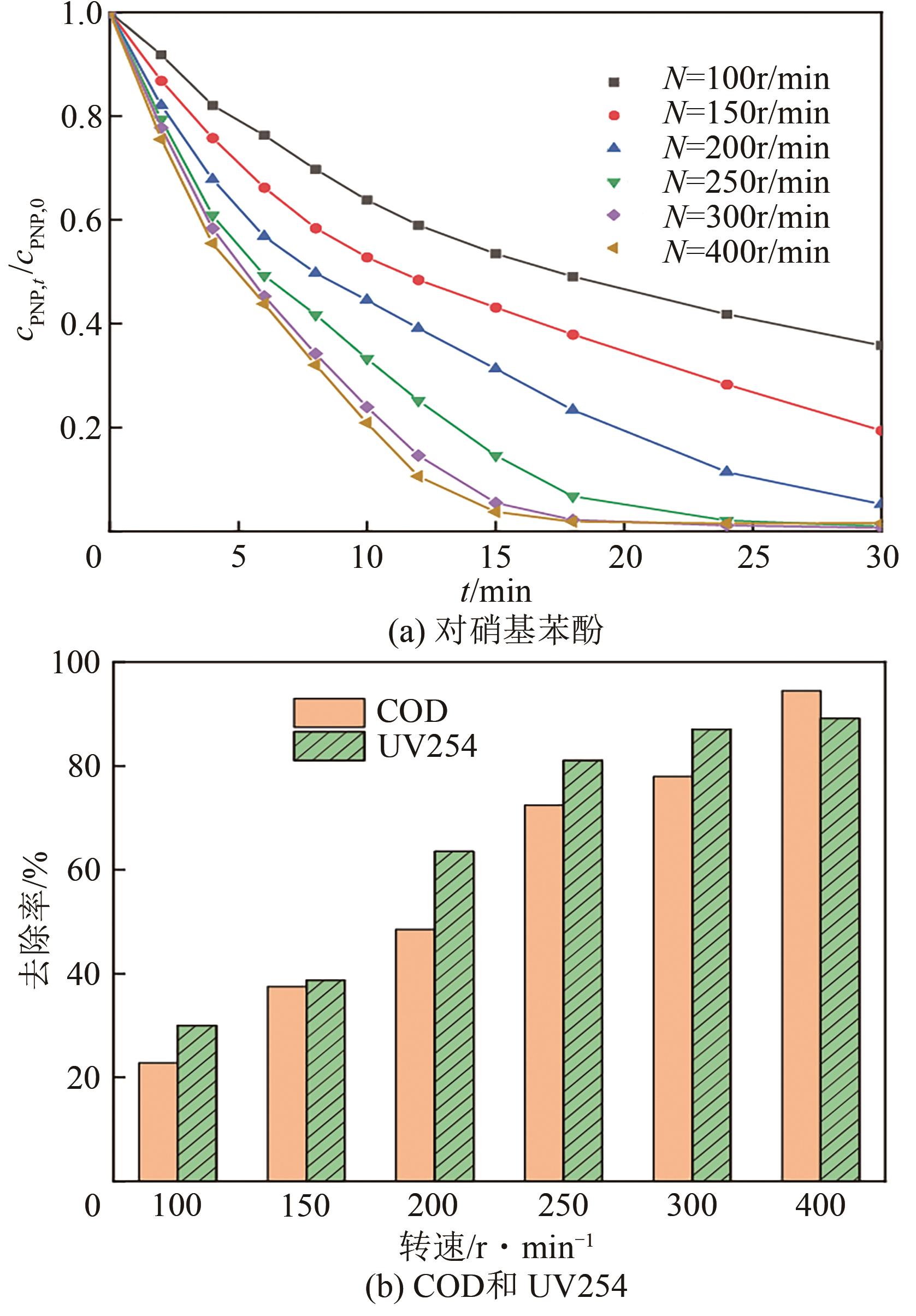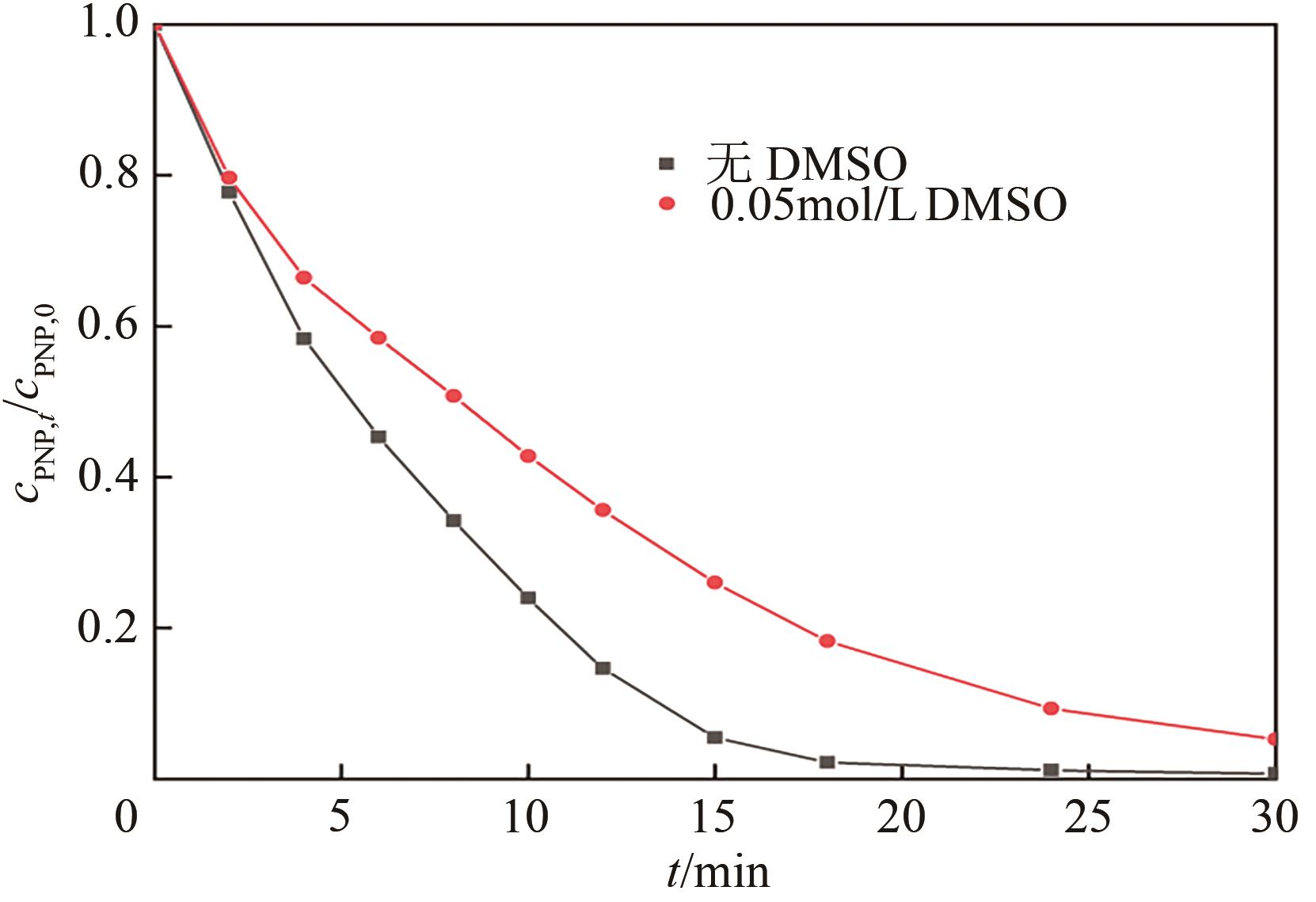Chemical Industry and Engineering Progress ›› 2021, Vol. 40 ›› Issue (7): 4091-4099.DOI: 10.16085/j.issn.1000-6613.2020-1704
• Resources and environmental engineering • Previous Articles Next Articles
Enhanced ozone degradation of the p-nitrophenol wastewater by rotating-microbubble reactor
ZENG Shangsheng( ), YANG Yucheng(
), YANG Yucheng( ), ZHANG Na, ZHANG Xueqin, YE Jing, HUANG Yayan, XIAO Meitian
), ZHANG Na, ZHANG Xueqin, YE Jing, HUANG Yayan, XIAO Meitian
- School of Chemical Engineering, Huaqiao University, Xiamen 361021, Fujian, China
-
Received:2020-08-26Revised:2020-11-15Online:2021-07-19Published:2021-07-06 -
Contact:YANG Yucheng
旋转微气泡反应器强化臭氧降解水中对硝基苯酚
曾尚升( ), 杨宇成(
), 杨宇成( ), 张娜, 张学勤, 叶静, 黄雅燕, 肖美添
), 张娜, 张学勤, 叶静, 黄雅燕, 肖美添
- 华侨大学化工学院,福建 厦门 361021
-
通讯作者:杨宇成 -
作者简介:曾尚升(1994—),男,硕士研究生,研究方向为水污染治理。E-mail:18014087001@stu.hqu.edu.cn 。 -
基金资助:国家自然科学基金(21808071);华侨大学研究生科研创新能力培育计划;厦门市高校科研院所产学研项目(3502Z20193042)
CLC Number:
Cite this article
ZENG Shangsheng, YANG Yucheng, ZHANG Na, ZHANG Xueqin, YE Jing, HUANG Yayan, XIAO Meitian. Enhanced ozone degradation of the p-nitrophenol wastewater by rotating-microbubble reactor[J]. Chemical Industry and Engineering Progress, 2021, 40(7): 4091-4099.
曾尚升, 杨宇成, 张娜, 张学勤, 叶静, 黄雅燕, 肖美添. 旋转微气泡反应器强化臭氧降解水中对硝基苯酚[J]. 化工进展, 2021, 40(7): 4091-4099.
share this article
Add to citation manager EndNote|Ris|BibTeX
URL: https://hgjz.cip.com.cn/EN/10.16085/j.issn.1000-6613.2020-1704
| 1 | OTURAN M A, PEIROTEN J, CHARTRIN P, et al. Complete destruction of p-nitrophenol in aqueous medium by electro-Fenton method[J]. Environmental Science & Technology, 2000, 34(16): 3474-3479. |
| 2 | 周文敏, 傅德黔, 孙宗光. 中国水中优先控制污染物黑名单的确定[J]. 环境科学研究, 1991, 4(6): 9-12. |
| ZHOU W M, FU D Q, SUN Z G. Determination of black list of China's priority pollutants in water[J]. Research of Environmental Sciences, 1991, 4(6): 9-12. | |
| 3 | ZHENG H, GUO Y, ZHU H, et al. p-Nitrophenol enhanced degradation in high-voltage pulsed corona discharges combined with ozone system[J]. Plasma Chemistry & Plasma Processing, 2013, 33(6): 1053-1062. |
| 4 | LIN S H, WANG C H. Ozonation of phenolic wastewater in a gas-induced reactor with a fixed granular activated carbon bed[J]. Industrial & Engineering Chemistry Research, 2003, 42(8): 1648-1653. |
| 5 | QI Y N. Ozonation of water and waste water: a practical guide to understanding ozone and its applications[J]. International Journal of Environmental Studies, 2010, 67(5): 795-796. |
| 6 | LIU T R, WANG D, WANG W, et al. Study on the efficient production of ozone water by a rotating packed bed[J]. Industrial & Engineering Chemistry Research, 2019, 58(17): 7227-7232. |
| 7 | WANG B, XIONG X, SHUI Y Y, et al. A systematic study of enhanced ozone mass transfer for ultrasonic-assisted PTFE hollow fiber membrane aeration process[J]. Chemical Engineering Journal, 2019, 357: 678-688. |
| 8 | BEGUM A, GAUTAM S K. Endosulfan and lindane degradation using ozonation[J]. Environmental Technology, 2012, 33(8): 943-949. |
| 9 | SHIN W T, MIRMIRAN A, YIACOUMI S, et al. Ozonation using microbubbles formed by electric fields[J] . Separation and Purification Technology, 1999, 15(3): 271-282. |
| 10 | HOIGNE J, BADER H, HAAG W R, et al. Rate constants of reactions of ozone with organic and inorganic compounds in water—Ⅲ. Inorganic compounds and radicals[J]. Water Research, 1985, 19(8): 993-1004. |
| 11 | ZHU S M, DONG B Z, YU Y H, et al. Heterogeneous catalysis of ozone using ordered mesoporous Fe3O4 for degradation of atrazine[J]. Chemical Engineering Journal, 2017, 328: 527-535. |
| 12 | CHU L B, XING X H, YU A F, et al. Enhanced ozonation of simulated dyestuff wastewater by microbubbles[J]. Chemosphere, 2007, 68(10): 1854-1860. |
| 13 | TAKAHSHI M, HORIBE H, MATSUURA K, et al. Effect of microbubbles on ozonized water for photoresist removal[J]. Journal of Photopolymer Science and Technology, 2015, 28(2): 293-298. |
| 14 | 杨宇成, 杨时颖, MOSES Arowo. 旋转泡沫填料反应器的研究进展[J]. 化工进展, 2018, 37(6): 21-27. |
| YANG Y C, YANG S Y, MOSES Arowo. Research progress in a rotating foam reactor[J]. Chemical Industry and Engineering Progress, 2018, 37(6): 2046-2052. | |
| 15 | TSCHENTSCHER R, NIJHUIS T A, SCHAAF J VAN DER, et al. Glucose oxidation in slurry reactors and rotating foam reactors[J]. Industrial & Engineering Chemistry Research, 2012, 51(4): 1620-1634. |
| 16 | LALI F, BÖTTCHER G, SCHÖNEICH P M, et al. Preparation and characterization of Pd/Al2O3 catalysts on aluminum foam supports for multiphase hydrogenation reactions in rotating foam reactors[J]. Chemical Engineering Research and Design: Transactions of the Institution of Chemical Engineers, 2015, 94: 365-374. |
| 17 | YANG Y C, YU X H, YU Q J, et al. Micromixing efficiency in a multiphase reactor with a foam block stirrer[J]. The Canadian Journal of Chemical Engineering, 2019, 97: 1560-1567. |
| 18 | YANG Y C, OUYANG Y, YU X H, et al. Micromixing efficiency in a rotating foam stirrer reactor with various reactor configurations and liquid viscosities[J]. Journal of Chemical Technology & Biotechnology, 2019, 94(8): 2651-2660. |
| 19 | TSCHENTSCHER R, SPIJKERS R J P, NIJHUIS T A, et al. Liquid-solid mass transfer in agitated slurry reactors and rotating solid foam reactors[J]. Industrial & Engineering Chemistry Research, 2010, 49(21): 10758-10766. |
| 20 | BADER H, HOIGNE J. Determination of ozone in water by the indigo method[J]. Water Research, 1981, 15(4): 449-456. |
| 21 | KUKUZAKI M, FUJIMOTO K, KAI S, et al. Ozone mass transfer in an ozone-water contacting process with Shirasu porous glass (SPG) membranes—A comparative study of hydrophilic and hydrophobic membranes[J]. Separation & Purification Technology, 2010, 72(3): 347-356. |
| 22 | BIN A K. Ozone dissolution in aqueous systems treatment of the experimental data[J]. Experimental Thermal & Fluid Science, 2004, 28(5): 395-405. |
| 23 | FLYUNT R, LEITZKE A, MARK G, et al. Determination of ·OH, O2-·, and hydroperoxide yields in ozone reactions in aqueous solution[J]. The Journal of Physical Chemistry B, 2003, 107(30): 7242-7253. |
| 24 | 李哲. 类Fenton反应中羟基自由基生成的化学发光动力学研究及其在灭菌和染料降解中的应用[D]. 北京: 北京化工大学, 2019. |
| LI Z. Chemiluminescence kinetic study on the generation of hydroxyl radicals in Fenton-like reaction and its application in sterilization and dye degradation processes[D]. Beijing: Beijing University of Chemical Technology, 2019. | |
| 25 | 沈慧芳. 几种有机物臭氧化或复合氧化的动力学和传质研究[D]. 广州: 华南理工大学, 2002. |
| SHEN H F. Kineties and mass transfer studies of oxidaton of organic compounds in solutions containing ozone with or without hydrogen peroxide[D]. Guangzhou: South China University of Technology, 2002. | |
| 26 | HWANG B K, SON H S, KIM J H, et al. Decomposition of excess sludge in a membrane bioreactor using a turbulent jet flow ozone contactor[J]. Journal of Industrial & Engineering Chemistry, 2010, 16(4): 602-608. |
| 27 | TIAN X, WANG C, TRZCINSKI A P, et al. Interpreting the synergistic effect in combined ultrasonication-ozonation sewage sludge pre-treatment[J]. Chemosphere, 2015, 140: 63-71. |
| 28 | 倪丽, 郭晓滨, 金菁. 絮凝沉淀-臭氧氧化法处理DDNP生产废水[J]. 科技信息, 2009(4): 398-399. |
| NI L, GUO X B, JIN J. Flocculation sedimentation-ozone oxidation method to treat DDNP production wastewater[J]. Science & Technology Information, 2009(4): 398-399. | |
| 29 | GAO MT, HIRATA M, TAKANASHI H, et al. Ozone mass transfer in a new gas-liquid contactor-Karman contactor[J]. Separation and Purification Technology, 2005, 42(2): 145-149. |
| 30 | KUOSA M, KALLAS J, HAKKINEN A. Ozonation of p-nitrophenol at different pH values of water and the influence of radicals at acidic conditions[J]. Journal of Environmental Chemical Engineering, 2015, 3(1): 325-332. |
| 31 | LIN S H, WANG C H. Industrial wastewater treatment in a new gas-induced ozone reactor[J]. Journal of Hazardous Materials, 2003, 98(1/2/3): 295-309. |
| 32 | 刘亚坤. 金属氧化物催化臭氧氧化对硝基苯酚的研究[D]. 武汉: 武汉理工大学, 2012. |
| LIU Y K. Catalytic ozonation of p-nitrophenol by metal oxides[D]. Wuhan: WuhanUniversity of Technology, 2012. | |
| 33 | MA J, SUI M H, ZHANG T, et al. Effect of pH on MnOx/GAC catalyzed ozonation for degradation of nitrobenzene[J]. Water Research, 2005, 39(5): 779-786. |
| 34 | GAO M P, ZENG Z Q, SUN B C, et al. Ozonation of azo dye Acid Red 14 in a microporous tube-in-tube microchannel reactor: decolorization and mechanism[J]. Chemosphere, 2012, 89(2): 190-197. |
| 35 | HE Z Q, LIN L L, SONG S, et al. Mineralization of C.I. reactive Blue 19 by ozonation combined with sonolysis: performance optimization and degradation mechanism[J]. Separation & Purification Technology, 2008, 62(2): 376-381. |
| 36 | KHALIL T T, BAZZI R, ROUX S, et al. The contribution of hydrogen peroxide to the radiosensitizing effect of gold nanoparticles[J]. Colloids & Surfaces B: Biointerfaces, 2019, 175: 606-613. |
| 37 | BUXTON G V, GREENSTOCK C L, HELMAN W P, et al. Critical review of rate constants for reactions of hydrated electrons, hydrogen atoms and hydroxyl radicals (·OH/·O-) in aqueous solution[J]. Journal of Physical and Chemical Reference Data, 1988, 17(2): 513-886. |
| [1] | SHENG Weiwu, CHENG Yongpan, CHEN Qiang, LI Xiaoting, WEI Jia, LI Linge, CHEN Xianfeng. Operating condition analysis of the microbubble and microdroplet dual-enhanced desulfurization reactor [J]. Chemical Industry and Engineering Progress, 2023, 42(S1): 142-147. |
| [2] | HUANG Yiping, LI Ting, ZHENG Longyun, QI Ao, CHEN Zhenglin, SHI Tianhao, ZHANG Xinyu, GUO Kai, HU Meng, NI Zeyu, LIU Hui, XIA Miao, ZHU Kai, LIU Chunjiang. Hydrodynamics and mass transfer characteristics of a three-stage internal loop airlift reactor [J]. Chemical Industry and Engineering Progress, 2023, 42(S1): 175-188. |
| [3] | YANG Hanyue, KONG Lingzhen, CHEN Jiaqing, SUN Huan, SONG Jiakai, WANG Sicheng, KONG Biao. Decarbonization performance of downflow tubular gas-liquid contactor of microbubble-type [J]. Chemical Industry and Engineering Progress, 2023, 42(S1): 197-204. |
| [4] | CHEN Kuangyin, LI Ruilan, TONG Yang, SHEN Jianhua. Structure design of gas diffusion layer in proton exchange membrane fuel cell [J]. Chemical Industry and Engineering Progress, 2023, 42(S1): 246-259. |
| [5] | XU Jiaheng, LI Yongsheng, LUO Chunhuan, SU Qingquan. Optimization of methanol steam reforming process [J]. Chemical Industry and Engineering Progress, 2023, 42(S1): 41-46. |
| [6] | GAO Yufei, LU Jinfeng. Mechanism of heterogeneous catalytic ozone oxidation:A review [J]. Chemical Industry and Engineering Progress, 2023, 42(S1): 430-438. |
| [7] | XU Chunshu, YAO Qingda, LIANG Yongxian, ZHOU Hualong. Research progress on functionalization strategies of covalent organic frame materials and its adsorption properties for Hg(Ⅱ) and Cr(Ⅵ) [J]. Chemical Industry and Engineering Progress, 2023, 42(S1): 461-478. |
| [8] | SHAO Boshi, TAN Hongbo. Simulation on the enhancement of cryogenic removal of volatile organic compounds by sawtooth plate [J]. Chemical Industry and Engineering Progress, 2023, 42(S1): 84-93. |
| [9] | LIU Xuanlin, WANG Yikai, DAI Suzhou, YIN Yonggao. Analysis and optimization of decomposition reactor based on ammonium carbamate in heat pump [J]. Chemical Industry and Engineering Progress, 2023, 42(9): 4522-4530. |
| [10] | LUO Cheng, FAN Xiaoyong, ZHU Yonghong, TIAN Feng, CUI Louwei, DU Chongpeng, WANG Feili, LI Dong, ZHENG Hua’an. CFD simulation of liquid distribution in different distributors in medium-low temperature coal tar hydrogenation reactor [J]. Chemical Industry and Engineering Progress, 2023, 42(9): 4538-4549. |
| [11] | CHENG Tao, CUI Ruili, SONG Junnan, ZHANG Tianqi, ZHANG Yunhe, LIANG Shijie, PU Shi. Analysis of impurity deposition and pressure drop increase mechanisms in residue hydrotreating unit [J]. Chemical Industry and Engineering Progress, 2023, 42(9): 4616-4627. |
| [12] | WANG Chen, BAI Haoliang, KANG Xue. Performance study of high power UV-LED heat dissipation and nano-TiO2 photocatalytic acid red 26 coupling system [J]. Chemical Industry and Engineering Progress, 2023, 42(9): 4905-4916. |
| [13] | SHI Tianxi, SHI Yonghui, WU Xinying, ZHANG Yihao, QIN Zhe, ZHAO Chunxia, LU Da. Effects of Fe2+ on the performance of Anammox EGSB reactor [J]. Chemical Industry and Engineering Progress, 2023, 42(9): 5003-5010. |
| [14] | LI Dong, WANG Qianqian, ZHANG Liang, LI Jun, FU Qian, ZHU Xun, LIAO Qiang. Performance of series stack of non-aqueous nano slurry thermally regenerative flow batteries [J]. Chemical Industry and Engineering Progress, 2023, 42(8): 4238-4246. |
| [15] | DENG Jian, WANG Kai, LUO Guangsheng. Development and consideration of adiabatic continuous microreaction technology for safe production of nitro compounds [J]. Chemical Industry and Engineering Progress, 2023, 42(8): 3923-3925. |
| Viewed | ||||||
|
Full text |
|
|||||
|
Abstract |
|
|||||












